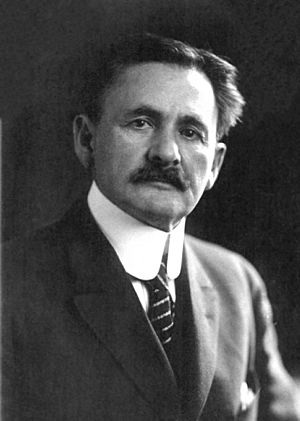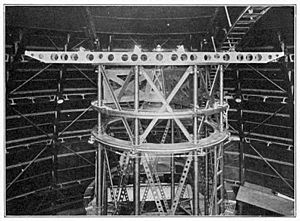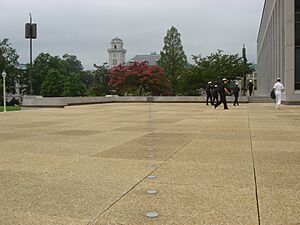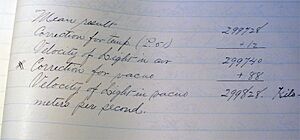Albert A. Michelson facts for kids
Quick facts for kids
Albert A. Michelson
|
|
|---|---|

Michelson in 1907
|
|
| Born | December 19, 1852 Strelno, Kingdom of Prussia, German Confederation
|
| Died | May 9, 1931 (aged 78) Pasadena, California, U.S.
|
| Nationality | American |
| Alma mater | United States Naval Academy University of Berlin |
| Known for | Speed of light Hyperfine structure Fine structure Michelson–Morley experiment Michelson–Gale–Pearson experiment Michelson interferometer Michelson stellar interferometer |
| Spouse(s) |
Margaret Hemingway
(m. 1877; div. 1898)Edna Stanton
(m. 1899) |
| Military career | |
| Allegiance | |
| Branch | |
| Service years | 1873–1881; 1918–1921 |
| Rank | Commander |
| Unit | United States Naval Academy |
| Awards | Matteucci Medal (1903) Nobel Prize in Physics (1907) Copley Medal (1907) Elliott Cresson Medal (1912) Henry Draper Medal (1916) Albert Medal (1920) Franklin Medal (1923) Duddell Medal and Prize (1929) |
| Scientific career | |
| Fields | Physics |
| Institutions | Case Western Reserve University Clark University University of Chicago |
| Doctoral advisor | Hermann von Helmholtz |
| Other academic advisors | Georg Hermann Quincke Alfred Cornu |
| Doctoral students |
|
| Signature | |
Albert Abraham Michelson (December 19, 1852 – May 9, 1931) was a Poland-born American physicist. He is famous for his work on measuring the speed of light. He is especially known for the Michelson–Morley experiment.
In 1907, he won the Nobel Prize in Physics. He was the first American to win a Nobel Prize in science. He also started the physics departments at Case School of Applied Science (now Case Western Reserve University) and the University of Chicago.
Contents
Life and Discoveries
Albert Michelson was born in Strelno, which was part of Prussia (now Strzelno, Poland). His parents were Jewish. When he was two, in 1855, his family moved to the United States. He grew up in mining towns in California and Nevada. His father was a merchant.
In 1869, President Ulysses S. Grant helped Michelson get into the U.S. Naval Academy. During his time there, he was excellent in subjects like optics (the study of light), heat, and drawing. After graduating in 1873, he spent two years at sea. Then, he returned to the Naval Academy in 1875 to teach physics and chemistry.
Michelson was very interested in science, especially in finding the exact speed of light. In 1877, he did his first experiments on the speed of light as a class demonstration. He improved his method and, in 1879, measured the speed of light in air. He also estimated the speed of light in a vacuum.
After studying in Europe for two years, he left the United States Navy in 1881. In 1883, he became a physics professor at the Case School of Applied Science in Cleveland, Ohio. There, he worked on making a better interferometer. This is a tool that uses light waves to make very precise measurements.
In 1887, he and Edward Morley did the famous Michelson–Morley experiment. They tried to find evidence of something called the "luminiferous ether." This was a made-up substance that scientists thought light traveled through. However, their experiment found no sign of it. This surprising result was very important in physics. It helped lead to Albert Einstein's theory of special relativity.
In 1889, Michelson became a professor at Clark University. In 1892, he became the first head of the physics department at the new University of Chicago.
In 1907, Michelson received the Nobel Prize in Physics. He was honored for his precise optical tools and his work in studying light and measurements. He also won other important awards, like the Copley Medal in 1907. A crater on the Moon is named after him.
Michelson returned to military service briefly during World War I. He served in the Naval Reserve. He died in Pasadena, California, at the age of 78. Many buildings and awards are named after him to honor his achievements.
Measuring the Speed of Light
Michelson was fascinated by light throughout his life. When asked why he studied light, he simply said, "because it’s so much fun."
Early Experiments
Michelson started planning to measure the speed of light in 1869. He wanted to improve on earlier methods using a spinning mirror. He did his first measurements in 1878.
His main experiments took place in 1879. He built a special building to hold his equipment. He published his result for the speed of light, which was very close to what we know today. He then worked with Simon Newcomb, another scientist, on similar measurements.
Michelson kept improving his method. He published another measurement in 1883, which was even more accurate.
Later Measurements
From 1920, Michelson planned a very precise measurement from the Mount Wilson Observatory. He used a long distance to Lookout Mountain, about 22 miles away.
Measurements were done over two years. He published a value for the speed of light that was very accurate. This experiment was difficult because of haze from forest fires.
Later, Michelson wanted to measure the speed of light in a vacuum. This would avoid problems caused by the atmosphere. In 1929, he started working with Francis G. Pease and Fred Pearson. They used a 1.6-kilometer-long tube with almost no air inside. The light path was made even longer by using many reflections. Michelson passed away before the experiment was finished. The final result was published after his death in 1935.
Michelson was very careful in his experiments. He repeated his measurements many times to get the most accurate results possible. He understood that repeating measurements helps reduce errors.
Michelson–Morley Experiment
In 1887, Michelson worked with Edward Morley on a famous experiment. They wanted to find out if the Earth moved through a substance called the "luminiferous aether." Scientists at the time thought this aether was how light traveled through space.
Their experiment showed no evidence of this aether. This was a "null result," meaning they didn't find what they expected. Michelson repeated the experiment with even more precision, but still found no sign of the aether.
The results of the Michelson–Morley experiment were very important. They helped Albert Einstein develop his theory of special relativity. This theory said that the aether was not needed. Today, this experiment is seen as a key moment in showing that the aether doesn't exist.
The precise tools used by Michelson and Morley also helped them measure the "fine structure" in atomic light patterns. This was an important step in understanding how atoms work.
Astronomical Interferometry
Optical Interferometry

In 1920, Michelson and Francis G. Pease made the first measurement of a star's diameter other than our Sun. Michelson invented a tool called an astronomical interferometer. They used it at the Mount Wilson Observatory to measure the size of a giant red star called Betelgeuse.
This tool used mirrors to combine light from different parts of the star. This created patterns that helped them figure out the star's size. Measuring star sizes and the distances between binary stars (two stars orbiting each other) became a big part of Michelson's later work.
Today, modern observatories still use Michelson's idea of combining light from separate telescopes. This allows them to see details that a single telescope cannot.
Gravitational Wave Detection
Michelson interferometers are also used to detect gravitational waves. These are ripples in space and time caused by huge cosmic events. Scientists use giant Michelson interferometers with laser light. These have arms that are 4 kilometers long, set at right angles.
When a gravitational wave passes, it slightly stretches one arm and shortens the other. The interferometer is very sensitive to this tiny change. As of 2020, many gravitational wave events have been observed using these instruments.
Harmonic Analyzer
In the 1890s, Michelson built a mechanical device called the harmonic analyzer. This machine helped him compute complex mathematical patterns. It could also draw graphs of these patterns. He published a paper about this machine in 1898.
Honors and Awards

- 1888 – Rumford Prize
- 1903 – Matteucci Medal
- 1907 – Copley Medal
- 1907 – Nobel Prize in Physics
- 1912 – Elliott Cresson Medal
- 1916 – Henry Draper Medal
- 1922 – Prix Jules Janssen
- 1923 – Gold Medal of the Royal Astronomical Society
- 1923 – Franklin Medal
Michelson was a member of important scientific groups, including the Royal Society and the National Academy of Sciences.
Family
In 1877, Michelson married Margaret Hemingway. They had two sons and a daughter. In 1899, he married Edna Stanton, and they raised three daughters.
See Also
 In Spanish: Albert Abraham Michelson para niños
In Spanish: Albert Abraham Michelson para niños
- List of Jewish Nobel laureates
- List of Naval Academy Nobel Laureates
- List of Poles
Works
- (in en) Light waves and their uses. Chicago: University Press. 1907. https://gutenberg.beic.it/webclient/DeliveryManager?pid=11000649.
- Détermination expérimentale de la valeur du mètre en longueurs d'ondes lumineuses. Paris : Gauthier-Villars et fils, 1894. (French translation of Experimental Determination of the Velocity of Light)






